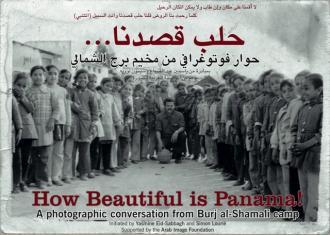A PHOTOGRAPHIC CONVERSATION FROM BURJ AL-SHAMALI CAMP
Amman(Makan)
Opening : 14th April 2009 At 6:30 and it will last till Thursday 30th April
Opening Hours : 2:00-6:00 pm ( Sunday till Thursday)
Talk : 15th April 2009 At 7:00 pm
Al-Husun Camp (Irbid)
Opening : 17th April 2009 at 3:00 pm
Talk : 17th April 2009 at 5:00 pm
The ongoing project “A Photographic Conversation from Burj al-Shamali Camp” is an open-ended exchange on the visual memory of the Burj al-Shamali Palestinian refugee camp in Lebanon. Herein is a two-part project that involves both producing photographic work with a group of youth from the camp, and research that aims to gather and preserve family and studio photographs from the camp community itself.
The exhibition “How beautiful is Panama!” produced in 2008, is one of the activities that was born from this exchange. By the summer of 2009, the exhibition will have toured several other camps in Lebanon, Jordan and Syria. A panel discussion on the archiving project will be held alongside the exhibition.
This project is presented by Yasmine Eid-Sabbagh and Simon Lourié.
It was made possible thanks to the collaboration and support of the Beit Atfal Assoumoud Centre of Burj al-Shamali, the Arab Image Foundation and the Prince Claus Fund.
The exhibition was supported by a grant from the Documentary
Photography Project of the Open Society Institute.
Projects Description:
1-collecting and preserving the camp’s photographs:
Gathering and preserving family and studio photographs from the camp seemed crucial as the camp residents’ current identity is built around a memory and history of Palestine which remains largely an abstract notion that is solely transmitted orally from a generation to the next. To this date, there have been no significant attempts to assemble the camp residents’ photographic materials, much less their visual memory at large.
As photographs represent a universal language, and as a record of past times may appeal to a large audience, collecting family photographs will ensure the safekeeping of priceless documents that serve as testaments to the myriad changes that the camps have gone though over the decades.
This project involves borrowing selections from family photographs and studio collections in order to digitize them and document them with information on place, time, subject, and photographer. Personal stories and other narrative asides will also be collected. One day a selection of photographs might be made accessible for education and research through a database system within the camps themselves.
2- How beautiful is Panama!
There is a famed German childrens tale by the name of “Oh wie schön ist Panama!“ (How beautiful is Panama!).
The exhibition “How beautiful is Panama” presents the work of six young Palestinians living in Borj al-Shamali camp. The participants include Ahmad al-Khalil, Ali al-Ali, Fatmeh Soleiman, Nisreen Musherfih, Susan al-Kahtib and Yasser Ibrahim.
Ahmad selected several different series of views of the camp that he had shot for review. His photographs have a highly formal aesthetic that involves shadow play, the particular quality of light at sunset, and a variety of unusual perspectives. In the end, he opted to exhibit a series exploring the theme of borders in the camp.
Mapping construction and deconstruction are also critical elements of Ali’s work. In one sequence of photographs selected for the show, he documents the construction of a mosque within the bounds of the camp over seven years.
Fatmeh’s aesthetic and working method is rather different. She is profoundly patient, often taking only one picture at a time - sometimes one over the course of a day, and at other times one every few weeks. In her selection of images she addressed two very different, though related, issues – the interplay between the reality around her and her will to dream.
Nisreen chose to exhibit recent work. The theme she addressed through the photos was her wish to honour the dead using another aesthetic than the predominant iconic commemorative imagery associated with martyrdom. All her photos celebrate people who lived in Burj al-Shamali, and she memorialized them in the collective memory of the community through photographs.
Susan, who by then was married and living outside of Burj al-Shamali in al-Buss camp, asked me to include the series of photos she had taken of doors, but also the more private images that depicted the interiors of people’s homes. These photos are remarkable for the way in which they reveal – obliquely – not only the diversity of people’s taste in home decor but also the kind of living conditions that now characterize camp life.
Yasser chose the overarching theme of Palestine and photographed camp elders – those who knew the Palestine he never did. He also decided to focus on the camp’s visual environment. In particular he was interested in the ways that factions and associations compete with one another through poster campaigns throughout the camp, papered over walls, doors and electricity pylons. The sequence of images he chose was, in effect, a visual chronicle of those battles.


